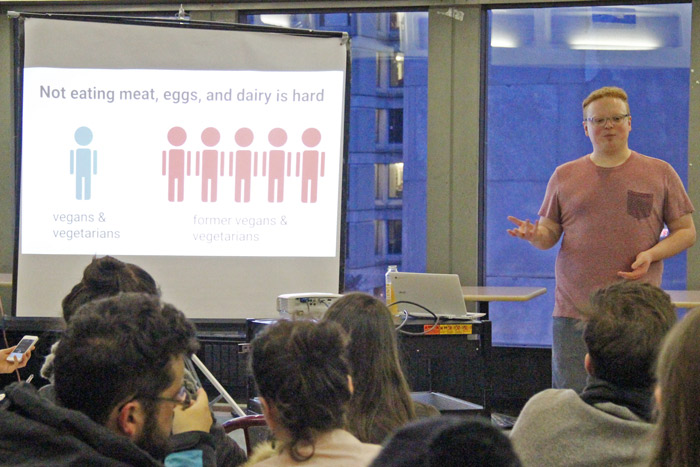Which came first: The chicken or the egg? In the not too distant future, the popular dilemma may become less universal.
On March 13, Effective Altruists at McGill, with the support of Greenpeace McGill, hosted an informative presentation delivered by co-President Yarrow Eady entitled, “Saving the World through Biotechnology.”
Eady began by highlighting the environmental and health-related costs of the modern animal agriculture industry, including its contribution of about 14.5 per cent of global greenhouse gas emissions, susceptibility to disease epidemics, and its role in creating antibiotic-resistant bacteria.
The harsh treatment of animals in the name of efficiency poses an additional ethical concern, which is implicitly acknowledged by laws that prohibit filming in factory farms.
“The reality is that like everything else that we buy, animal products are produced in huge industrial facilities that don’t look like farms look in the popular imagination,” Eady said.
However, significantly reducing demand for animal products—especially in the face of rapid global population growth—is hardly realistic. A 2014 study showed that as many as 84 per cent of people who attempted a vegan or vegetarian diet returned to eating meat or other animal products.
Enter cellular agriculture—a field that aims to create molecular duplicates of animal products on a cellular or subcellular level. In the near future, this pioneering industry promises to serve lab-grown meat, eggs, and dairy products that perfectly mimic the properties of their naturally-derived equivalents, but spare us the troubling aftertaste of environmental and ethical implications. Indeed, the production of animal products in a lab requires significantly less energy, land, and water, and produces less greenhouse gas than traditional farming.
“The biotechnological solution to animal agriculture would be like making a cigarette that has the same experience for the smoker, but has no negative impact on human health,” Eady said. “You wouldn’t have to deal with the super hard behaviour change problem.”
The first cultured beef burger, created by Dr. Mark Post at Maastricht University, famously debuted in London in 2013. Its design began with extraction of muscle stem cells from a living cow. The cells were allowed to grow and divide in an artificial environment supplied with growth medium. In the absence of blood vessels to deliver nutrients to and remove waste from cells directly, tissue could only grow to a limited size, so many tiny strands had to be layered together in the final beef patty.
The cell culture still relied on fetal bovine serum—a product extracted from fetal cows. Ongoing research continues to look for sustainable animal-free alternatives for growth media.
Re-creation of egg whites and dairy, on the other hand, relies only on the dutiful service of yeast. Egg whites are made up of protein, whereas milk contains both proteins and fats. Yeast DNA is modified by inserting genes that drive the yeast to produce desired proteins. The yeast consumes sugar and divides while obediently secreting these target proteins, which are then isolated from the yeast. In the case of milk, plant-sourced fats are then added.
While a variety of cellular agriculture research is currently funded by non-profit institutes, notably New Harvest, some biotechnology companies have surprisingly attracted investors from the animal agriculture industry.
“It’s like the innovator’s dilemma where these [animal agriculture] companies can see the future, but the future also destroys the present business,” Eady said. “[….] Maybe some will drag their heels, [but] others will try and get ahead of this [and] go along with the future rather than fight against it.”
Cellular agriculture might be closer than one might imagine. Perfect Day, a startup developing animal-free dairy, promised to launch its first commercial product by the end of 2017.
As a self-proclaimed enthusiast of technological trends, Eady speculates that cellular agriculture will eventually advance beyond mere imitation of existing animal products.
“When you look beyond the five-year timespan, [it will be possible to manipulate biomolecules] with the same sort of detailed precision that we can manipulate software,” Eady said. “So, there’s a possibility in the very long-term for us to create entirely new foods, […which] no one today even imagines.”






